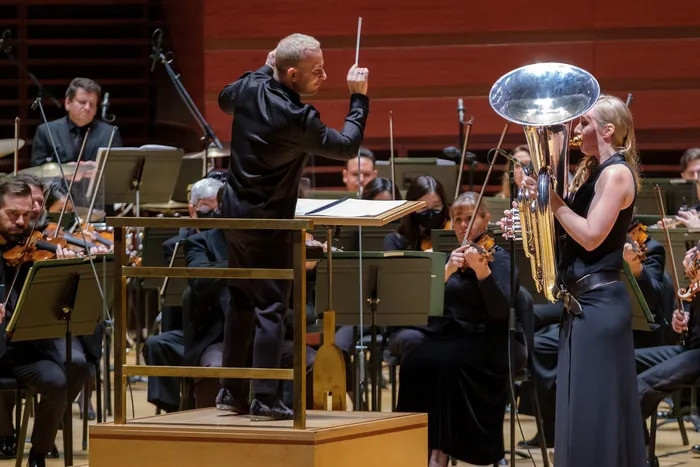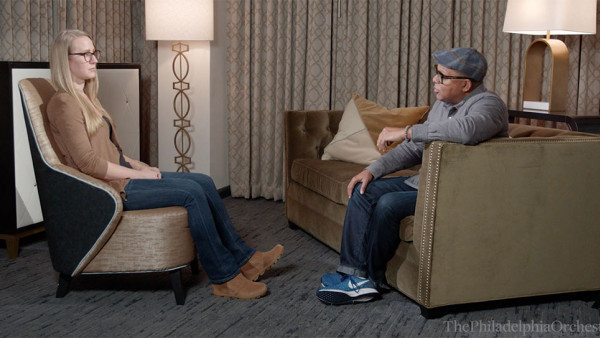Philadelphia Orchestra premieres Wynton Marsalis’s newest — a tuba concerto

(Carol Jantsch performing Marsalis’ Tuba Concerto – photo by Jeff Fusco)
Four words that were never likely to be found together are these: Wynton Marsalis Tuba Concerto.
But there they are on the Philadelphia Orchestra’s weekend subscription concerts, a world-premiere co-commission for an unusual soloist by the great jazz trumpeter/composer — in a program (repeated 2 p.m. Sunday at the Kimmel Center) that also features white-hot Brahms led by music director Yannick Nézet-Séguin. Performance-wise, what I heard Friday was in the top three concerts of Nézet-Séguin’s tenure —really — just as he is about to take a monthlong sabbatical.
Tuba concertos are few: The instrument is most often used as the foundation for the orchestra’s sonority, not something for the spotlight. But the orchestra’s Carol Jantsch significantly expands what the instrument can do, and Marsalis’s new concerto fuses those powers with a great sense of humor in a piece that must’ve been a blast to write.
Among the better known tuba concertos, Ralph Vaughan Williams surrounded the instrument with his customary prettiness, John Williams found depth of soul in the tuba’s depth of sound and Michael Daugherty used it as a source of American Impressionism. Marsalis’s playful, four-movement work often has the tuba lording over a busy mass of orchestral activity — I’ve long enjoyed his interruptive impulsivity and ability to go several directions at once — in what often seems like a catalog of rhythm, with the instrumentalist’s hand clapping as well as playing. But as much as he casts a wide net on this front, nothing is what it seems, whether it’s a near-but-not-quite bolero rhythm or a 1940s dance band reheard with 21st-century ears.
Jantsch’s intricate but effortless-sounding passagework wasn’t seriously tapped until the final movement — in a feat of delayed gratification that showed how Marsalis is conceiving long spans of music with greater clarity than before. Another new development in this piece is a witty sense of knowing when a movement needs to stop. And perhaps only a fellow brass player like Marsalis could hope for Jantsch’s convincing use of extended techniques that can be only vaguely described as simultaneous blowing and humming.
The Brahms Symphony No. 1 had its own kind of surprises, especially since Nézet-Séguin has previously lacked a convincing point of view for this composer’s symphonies. Not now. One portal may be Beethoven, whose fierce Symphony No 5 appears to be quoted in Brahms’ first movement: It seemingly unlocked a vision of Brahms that felt anything but comfortable, but tortured to the point of frenzy. The always arresting opening was twice the usual speed, which wasn’t just an effect but a structural pillar matched by the speed and intensity of the final movement. This was Brahms without the usual veneer — radically rethought but with an overall consistency that worked.
The orchestra’s string sound was full-bodied but too lean and purposeful to be lush. In the second and third movements, string portamento — a way of connecting the notes that died out in the 1950s — gave a sense of the music floating in mid-air. In the final movement’s chorale, the superb brass blend projected dignity and soul. But just so you know that everybody onstage remains human, some mildly messy entrances told you the orchestra was working at its limits.
Nézet-Séguin was firing on cylinders I didn’t know he had. And if his forthcoming sabbatical is what’s needed to maintain these kind of performances — plus his time-consuming commitment to new music — I say “Do it!”
The program will be repeated at 2 p.m. Sunday at the Kimmel Center. Tickets: $48-179. Information: 215-893-1999 or www.PhilOrch.org
by David Patrick Stearns
Source: The Philadelphia Inquirer

